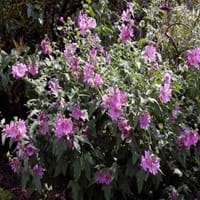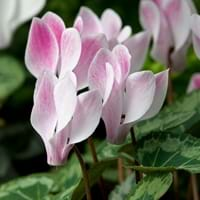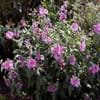Life Span
Annual, biennial or perennial
Perennial
Type
Tender Perennial
Flowering Plants, Tubers
Origin
Europe, Western Europe, Mediterranean
Europe, Mediterranean Basin, Middle East, North Africa, Somalia
Types
Lavatera Trimestris, Lavatera Thuringiaca, Lavatera Arborea
Cyclamen Africanum, Cyclamen Alpinum, Cyclamen Cilicium, Cyclamen Coum
Number of Varieties
Not Available
Habitat
Cliffs, Maritime Rocks
Alpine Meadows, Rocky areas, Woods
USDA Hardiness Zone
8-10
5-9
Sunset Zone
H1, 14, 15, 16, 17, 18, 19, 20, 21, 22, 23, 24
15, 16, 17, 18, 19, 20, 21, 22, 23, 24
Habit
Upright/Erect
Clump-Forming
Flower Color
Pink, Violet, Plum
Pink, Purple, White
Flower Color Modifier
Bicolor
Not Available
Fruit Color
Green, Tan
Brown
Leaf Color in Spring
Green
Several shades of Green
Leaf Color in Summer
Green
Not Available
Leaf Color in Fall
Green
Green, Silver
Leaf Color in Winter
Light Green
Green, Silver
Leaf Shape
Orbicular
Heart-shaped
Plant Season
Summer
Autumn, Spring, Summer, Winter
Sunlight
Full Sun, Partial Sun
Indirect sunlight
Type of Soil
Loam, Sand
Clay, Sandy, Well drained
The pH of Soil
Acidic, Neutral, Alkaline
Acidic
Soil Drainage
Well drained
Well drained
Bloom Time
Late Spring, Early Summer, Summer, Late Summer
Autumn, Spring, Summer
Tolerances
Drought
Not Available
Where to Plant?
Container, Ground
Container, Ground, Pot
How to Plant?
Divison, Seedlings
From bulbs, Seedlings
Plant Maintenance
Medium
Medium
Watering Requirements
Water deeply about once a week
Do not water frequently, It cannot sustain wet-feet, Keep the ground moist but not water-logged, Prefer drip-irrigation instead of Over-head watering, Water when soil is dry
In Summer
Lots of watering
Lots of watering
In Spring
Moderate
Moderate
In Winter
Average Water
Average Water
Soil pH
Acidic, Neutral, Alkaline
Acidic
Soil Type
Loam, Sand
Clay, Sandy, Well drained
Soil Drainage Capacity
Well drained
Well drained
Sun Exposure
Full Sun, Partial Sun
Indirect sunlight
Pruning
Pinching, Shearing, Thinning
Cut or pinch the stems, Prune if you want to improve plant shape, Prune ocassionally, Prune to control growth, Prune when plant is dormant, Remove dead leaves, Remove dead or diseased plant parts
Fertilizers
Water soluble fertilizers
All-Purpose Liquid Fertilizer
Pests and Diseases
Pests and diseases free
Aphids, Botrytis Cinerea, Gray mold, Mice, Mites, Root weevil, Slugs, Snails, Squirrels
Plant Tolerance
Drought
Drought
Flower Petal Number
Single
Single
Foliage Texture
Coarse
Medium
Foliage Sheen
Matte
Matte
Attracts
Birds, Butterflies
Not Available
Allergy
allergic reaction, Skin irritation
Respiratory problems
Aesthetic Uses
Cottage Garden
Showy Purposes
Beauty Benefits
Not Available
Not Available
Environmental Uses
Prevent Soil Erosion
Air purification
Medicinal Uses
Poultice
Digestive disorders, Menstrual Disorders
Part of Plant Used
Leaves
Root, Stem
Other Uses
Used in chopped mixed salad
Showy Purposes, Used as an ointment
Used As Indoor Plant
Yes
Yes
Used As Outdoor Plant
Yes
Yes
Garden Design
Feature Plant, Mixed Border, Screening / Wind Break, Wildflower
Not Available
Botanical Name
LAVATERA arborea
Cyclamen Persicum
Common Name
Tree Mallow
Cyclamen or Florist's Cyclamen
In Hindi
Tree Mallow
Sikalemen
In German
Baum Mallow
Zyklamen
In French
Arbre Mallow
Cyclamen
In Spanish
árbol de la malva
Ciclamen
In Greek
δέντρο Μολόχα
κυκλάμινο
In Portuguese
Mallow
Cíclame
In Polish
drzewo Mallow
Cyklamen
In Latin
ligno malvae
Cyclamīnos
Phylum
Magnoliophyta
Anthophyta
Class
Magnoliopsida
Dicotyledonae
Family
Malvaceae
Primulaceae
Clade
Angiosperms, Eudicots, Rosids
Not Available
Tribe
Malveae
Cyclamineae
Subfamily
Malvoideae
Myrsinoideae
Number of Species
Not Available
Season and Care of Tree Mallow and Cyclamen
Season and care of Tree Mallow and Cyclamen is important to know. While considering everything about Tree Mallow and Cyclamen Care, growing season is an essential factor. Tree Mallow season is Summer and Cyclamen season is Summer. The type of soil for Tree Mallow is Loam, Sand and for Cyclamen is Clay, Sandy, Well drained while the PH of soil for Tree Mallow is Acidic, Neutral, Alkaline and for Cyclamen is Acidic.
Tree Mallow and Cyclamen Physical Information
Tree Mallow and Cyclamen physical information is very important for comparison. Tree Mallow height is 210.00 cm and width 120.00 cm whereas Cyclamen height is 0.54 cm and width 0.75 cm. The color specification of Tree Mallow and Cyclamen are as follows:
Tree Mallow flower color: Pink, Violet and Plum
Tree Mallow leaf color: Green
Cyclamen flower color: Pink, Purple and White
- Cyclamen leaf color: Several shades of Green
Care of Tree Mallow and Cyclamen
Care of Tree Mallow and Cyclamen include pruning, fertilizers, watering etc. Tree Mallow pruning is done Pinching, Shearing and Thinning and Cyclamen pruning is done Cut or pinch the stems, Prune if you want to improve plant shape, Prune ocassionally, Prune to control growth, Prune when plant is dormant, Remove dead leaves and Remove dead or diseased plant parts. In summer Tree Mallow needs Lots of watering and in winter, it needs Average Water. Whereas, in summer Cyclamen needs Lots of watering and in winter, it needs Average Water.




